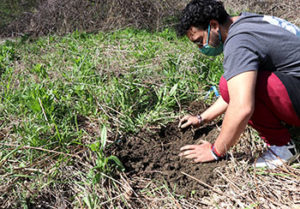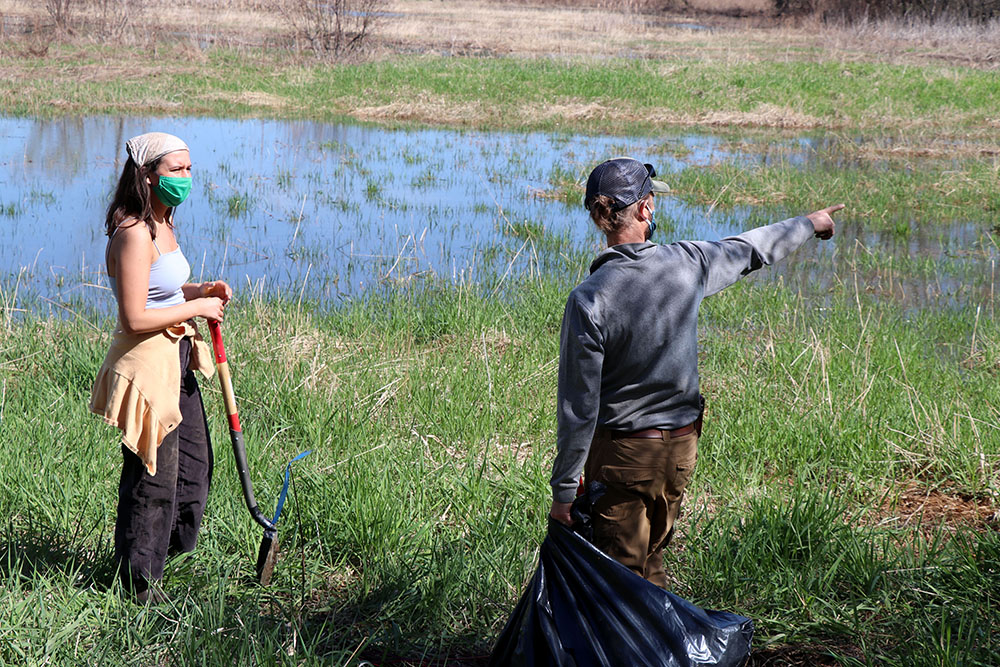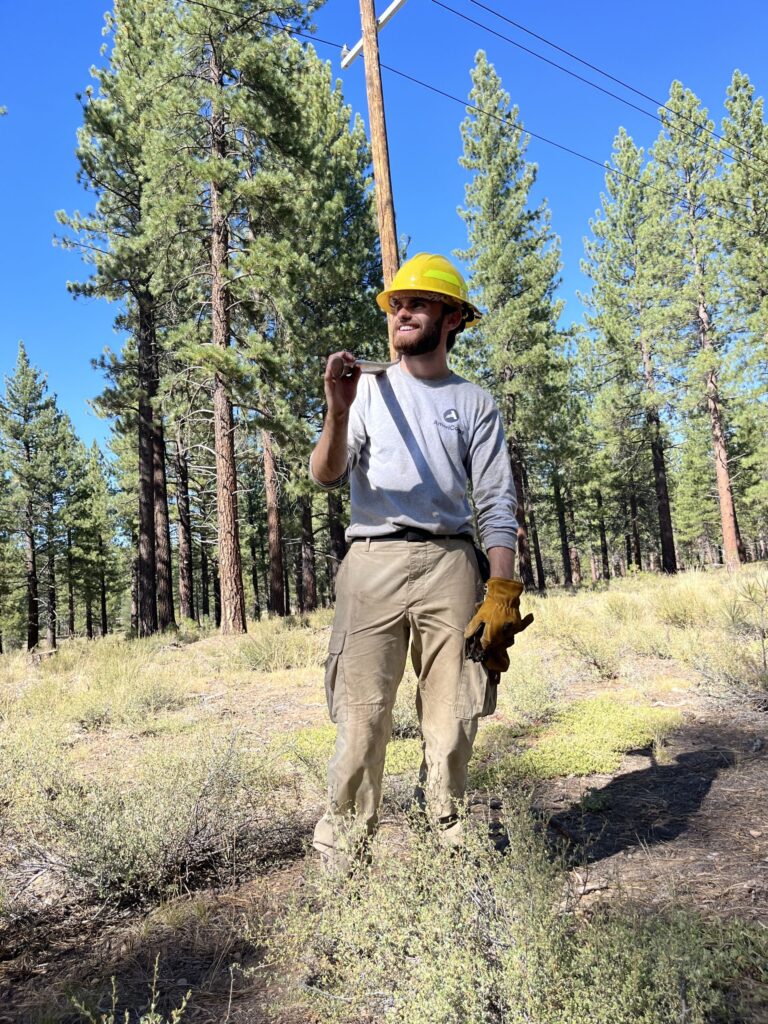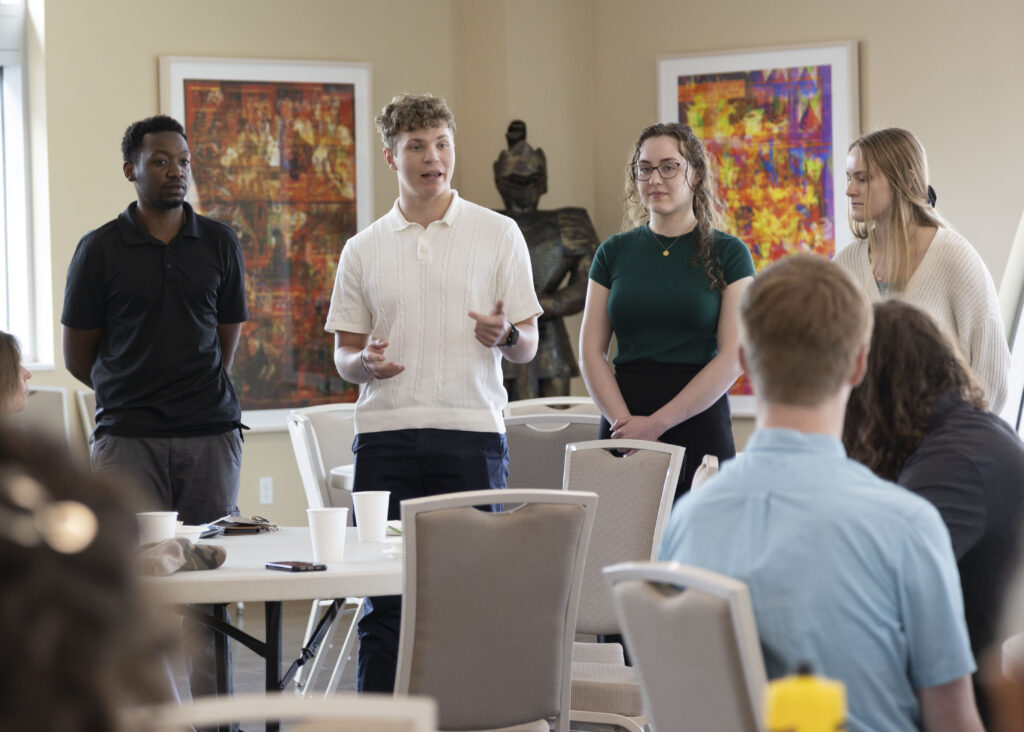Planting events foster growth across St. Mike’s campus
"Living laboratories" of Pollinator Garden, Nursery and Natural Area build ethos and expectation of environmental consciousness, Center director Achilich says.

Students plant trees in the Natural Area Saturday. Images from this site throughout story by Megan Schneider ’22)
Over the last week, several dozen students participated in stewarding their environment through “hyper-local” campus events, said Kristyn Achilich’05, Director of the Saint Michael’s College’s Institute for the Environment and an instructor of Environmental Studies & Sciences.
Achilich said the week’s activities culminated in a special volunteer planting push on Vermont Green-up Day (Saturday, May 1); all told over about a week, 70 students harvested, washed and planted spring crops on the farm, 30 or so planted native pollinator plants in the center of campus, complementing the tree nursery installed in fall of 2019, and another 30 found their way to the 360-acre Natural Area on the other side of Route 15 to contribute to the ecological restoration efforts of the college on the local watershed.

Students Saturday prepare the site for the Pollinator Garden on central campus.
“This ‘boots on the ground’ work is one small way we can ground our students intellectual knowledge and passions in what it takes to be environmentally conscious citizens,” Achilich said. “Our small size and deep mentoring model that is the tried and true identity of Saint Michael’s College allows for this work to happen in a way that empowers our students to act and lead, and feel a sense of completion and pride.”
“As we build our campus as a living laboratory for the hard and longitudinal work of environmental consciousness,” she continued, “I couldn’t be more proud and motivated to do this work alongside our students. Their efforts live on in the fabric of our campus community and build an ethos and expectation of continued consciousness for each subsequent year of students.”

The Pollinator Garden with work farther along Saturday. (images of this site by Shannon Harty)
The Pollinator Garden between Joyce and Alliot Hall is the second installment in that four-polygon area. In the past week, students worked the Teaching Gardens and Farm to divide and plant native perennial pollinating species to the new area. “These plants will serve as food and habitat for the pollinators needed to fertilize the nursery next door,” she said. “The benefits of being in more wild spaces are well documented, and this little wild meadow will be vibrant and full of life come fall, creating what’s sure to be a refuge for our students. What’s more, the area as a whole harnesses to the Farm, Teaching Gardens, and Natural Area that are harder to get to on a quick tour for prospective students.”

More tree-planting in the Natural Area Saturday. (photo by Megan Schneider ’22)
Trevien Stanger of the Environmental Studies and Sciences faculty says that, in another vibrant recent initiative led in large part by the student Green Up Club, more than 30 students and a handful of faculty met in the Natural Area for another round of tree-planting this past Saturday. “Together they planted over 150 silver maples, red maples, red-osier dogwoods, serviceberries, chokecherries, and winterberries— species well adapted to help restore biodiversity and beauty to the wetland conservation easement,” Stanger said. Green Mountain Audubon provided funding for the trees.

Meanwhile, Declan McCabe of the biology faculty reports that the College Facilities staff has also joined in the process of beautifying our campus with the addition of trees. “In anticipation of the loss of ash trees to the invading emerald ash borer, Saint Michael’s College is proactively planting 8 to 10 foot tall trees in locations between the 87 ash trees that will likely be lost to the invasive insect,” McCabe said. “While four fully mature and spectacularly large trees will be preserved using systemic injections into the trunks, most trees will be replaced by a planting regime focused on diversity.”
He said three trees were recently donated by the local organization called Branch Out Burlington and were installed in April; these will be followed by an additional 15 over summer. The trees planted thus far include tulip poplar and river birch. “Planting multiple species reduces the risk that some as yet unidentified insect or pathogen may overspread the area and put us back where we started,” McCabe said.
Shannon Harty of Green Up was the chief conductor for the pollinator project, Achilich said. Harty said Green Up club members spearheaded the construction of the pollinator garden, and that Club members also coordinated with students from Professor Brian Collier’s class who planned on constructing a pollinator garden for a class project. Close to 30 students participated in the Pollinator Garden Construction Event on Saturday May 1, including several students from Professor L’Hote’s Philosophy of Science, Technology and Environment course. Native perennials from the Farm and Teaching Gardens were split and transplanted with a goal of connecting the pollinator garden to outdoor teaching classrooms on campus.






